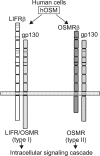Tenascin-X and leukemia inhibitory factor receptor are down-regulated in leiomyoma compared with normal myometrium
- PMID: 19471560
- PMCID: PMC2676457
- DOI: 10.3802/jgo.2008.19.2.139
Tenascin-X and leukemia inhibitory factor receptor are down-regulated in leiomyoma compared with normal myometrium
Abstract
Objective: Uterine leiomyomas are the most common tumor of the uterus. But the molecular causes of uterine leiomyoma remain unclear. We conducted the current investigation in order to elucidate the molecular mechanisms in the development of uterine leiomyoma.
Methods: We employed a new and accurate reverse transcription-polymerase chain reaction (RT-PCR) method that involved annealing control primers (ACPs) to identify the genes that are differently expressed in uterine leiomyoma.
Results: Using 120 ACPs, we identified and sequenced 14 differently expressed genes (DEGs) in uterine leiomyoma compared with normal myometrium. Basic Local Alignment Search Tool (BLAST) searches were performed to examine the known functions of these genes associated with uterine leiomyoma. We confirmed differently expressed patterns in more cases using the RT-PCR method. We also detected two novel genes, Tenascin-X and Leukemia Inhibitory Factor Receptor (LIFR), which had not yet been reported to have any functions associated with uterine leiomyoma. RT-PCR confirmation shows that both of these two genes are down-regulated in uterine leiomyoma.
Conclusion: Our results suggest that Tenascin-X and LIFR may play a role in the development of uterine leiomyoma. Although further studies are required to establish the precise mechanisms with which these genes are involved in the genesis of uterine leiomyoma, the present research is significant in that it is the first study which detects down-regulated novel genes in uterine leiomyoma using the ACP system.
Keywords: Annealing control primers (ACP) system; Leukemia inhibitory factor receptor (LIFR); Tenascin-X; Uterine leiomyoma.
Figures







Similar articles
-
Reduced expression of 14-3-3 gamma in uterine leiomyoma as identified by proteomics.Fertil Steril. 2008 Nov;90(5):1892-8. doi: 10.1016/j.fertnstert.2007.08.039. Epub 2007 Dec 11. Fertil Steril. 2008. PMID: 18054924
-
Systematic analysis of gene expression pattern in has-miR-197 over-expressed human uterine leiomyoma cells.Biomed Pharmacother. 2015 Oct;75:226-33. doi: 10.1016/j.biopha.2015.07.039. Epub 2015 Aug 24. Biomed Pharmacother. 2015. PMID: 26311392
-
[Primary study of genes related to uterine leiomyoma].Ai Zheng. 2004 Mar;23(3):292-5. Ai Zheng. 2004. PMID: 15025960 Chinese.
-
Epidemiological and genetic clues for molecular mechanisms involved in uterine leiomyoma development and growth.Hum Reprod Update. 2015 Sep-Oct;21(5):593-615. doi: 10.1093/humupd/dmv030. Epub 2015 Jul 3. Hum Reprod Update. 2015. PMID: 26141720 Free PMC article. Review.
-
The role of angiogenic factors in fibroid pathogenesis: potential implications for future therapy.Hum Reprod Update. 2014 Mar-Apr;20(2):194-216. doi: 10.1093/humupd/dmt042. Epub 2013 Sep 29. Hum Reprod Update. 2014. PMID: 24077979 Free PMC article. Review.
Cited by
-
Loss of Tenascin-X expression during tumor progression: A new pan-cancer marker.Matrix Biol Plus. 2020 Jan 20;6-7:100021. doi: 10.1016/j.mbplus.2020.100021. eCollection 2020 May. Matrix Biol Plus. 2020. PMID: 33543019 Free PMC article.
-
Revisiting the Tenascins: Exploitable as Cancer Targets?Front Oncol. 2022 Jun 17;12:908247. doi: 10.3389/fonc.2022.908247. eCollection 2022. Front Oncol. 2022. PMID: 35785162 Free PMC article. Review.
-
Genetic determinants of uterine fibroid size in the multiethnic NIEHS uterine fibroid study.Int J Mol Epidemiol Genet. 2015 Sep 9;6(1):9-19. eCollection 2015. Int J Mol Epidemiol Genet. 2015. PMID: 26417400 Free PMC article.
References
-
- Pokras R, Hufnagel VG. Hysterectomies in the United States 1965-84. Hyattsville, MD: US Department of Health and Human Services, Public Health Service, CDC; 1987. ((Vital and health statistics; series 13, no. 92)). DHHS publication no. (PHS) 88-1753. - PubMed
-
- Friedman AJ, Hoffman DI, Comite F, Browneller RW, Miller JD. Treatment of leiomyomata uteri with leuprolide acetate depot: A double-blind, placebo-controlled, multicenter study. The Leuprolide Study Group. Obstet Gynecol. 1991;77:720–725. - PubMed
-
- Brandon DD, Erickson TE, Keenan EJ, Strawn EY, Novy MJ, Burry KA, et al. Estrogen receptor gene expression in human uterine leiomyomata. J Clin Endocrinol Metab. 1995;80:1876–1881. - PubMed
-
- Yeh J, Rein M, Nowak R. Presence of messenger ribonucleic acid for epidermal growth factor (EGF) and EGF receptor demonstrable in monolayer cell cultures of myometria and leiomyomata. Fertil Steril. 1991;56:997–1000. - PubMed
-
- Pandis N, Heim S, Bardi G, Flodérus UM, Willén H, Mandahl N, et al. Chromosome analysis of 96 uterine leiomyomas. Cancer Genet Cytogenet. 1991;55:11–18. - PubMed
LinkOut - more resources
Full Text Sources
Research Materials
Miscellaneous

